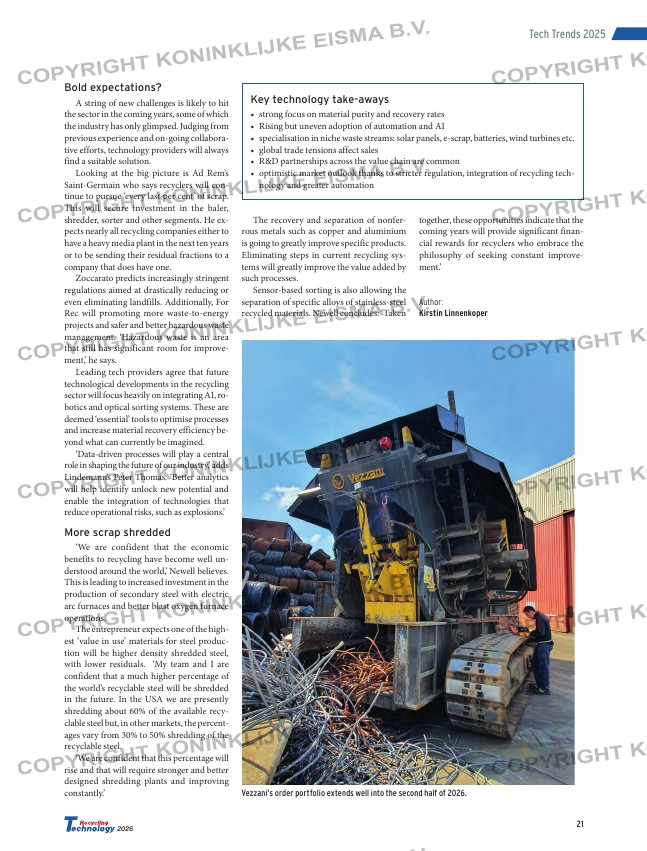Page 21 from: Recycling Technology edition 2026

21
2026
Tech Trends 2025
Author:
Kirstin Linnenkoper
Bold expectations?
A string of new challenges is likely to hit
the sector in the coming years, some of which
the industry has only glimpsed. Judging from
previous experience and on-going collabora-
tive efforts, technology providers will always
find a suitable solution.
Looking at the big picture is Ad Rem’s
Saint-Germain who says recyclers will con-
tinue to pursue ‘every last per cent’ of scrap.
This will secure investment in the baler,
shredder, sorter and other segments. He ex-
pects nearly all recycling companies either to
have a heavy media plant in the next ten years
or to be sending their residual fractions to a
company that does have one.
Zoccarato predicts increasingly stringent
regulations aimed at drastically reducing or
even eliminating landfills. Additionally, For
Rec will promoting more waste-to-energy
projects and safer and better hazardous waste
management. ‘Hazardous waste is an area
that still has significant room for improve-
ment,’ he says.
Leading tech providers agree that future
technological developments in the recycling
sector will focus heavily on integrating AI, ro-
botics and optical sorting systems. These are
deemed ‘essential’ tools to optimise processes
and increase material recovery efficiency be-
yond what can currently be imagined.
‘Data-driven processes will play a central
role in shaping the future of our industry,’ adds
Lindemann’s Peter Thomas. ‘Better analytics
will help identify unlock new potential and
enable the integration of technologies that
reduce operational risks, such as explosions.’
More scrap shredded
‘We are confident that the economic
benefits to recycling have become well un-
derstood around the world,’ Newell believes.
This is leading to increased investment in the
production of secondary steel with electric
arc furnaces and better blast oxygen furnace
operations.
The entrepreneur expects one of the high-
est ‘value in use’ materials for steel produc-
tion will be higher density shredded steel,
with lower residuals. ‘My team and I are
confident that a much higher percentage of
the world’s recyclable steel will be shredded
in the future. In the USA we are presently
shredding about 60% of the available recy-
clable steel but, in other markets, the percent-
ages vary from 30% to 50% shredding of the
recyclable steel.
‘We are confident that this percentage will
rise and that will require stronger and better
designed shredding plants and improving
constantly.’
The recovery and separation of nonfer-
rous metals such as copper and aluminium
is going to greatly improve specific products.
Eliminating steps in current recycling sys-
tems will greatly improve the value added by
such processes.
Sensor-based sorting is also allowing the
separation of specific alloys of stainless-steel
recycled materials. Newell concludes: ‘Taken
together, these opportunities indicate that the
coming years will provide significant finan-
cial rewards for recyclers who embrace the
philosophy of seeking constant improve-
ment.’
Vezzani’s order portfolio extends well into the second half of 2026.
Key technology take-aways
• strong focus on material purity and recovery rates
• Rising but uneven adoption of automation and AI
• specialisation in niche waste streams: solar panels, e-scrap, batteries, wind turbines etc.
• global trade tensions affect sales
• R&D partnerships across the value chain are common
• optimistic market outlook thanks to stricter regulation, integration of recycling tech-
nology and greater automation
16-17-18-19-20-21_rttrends2026.indd 21 27-08-2025 12:54



